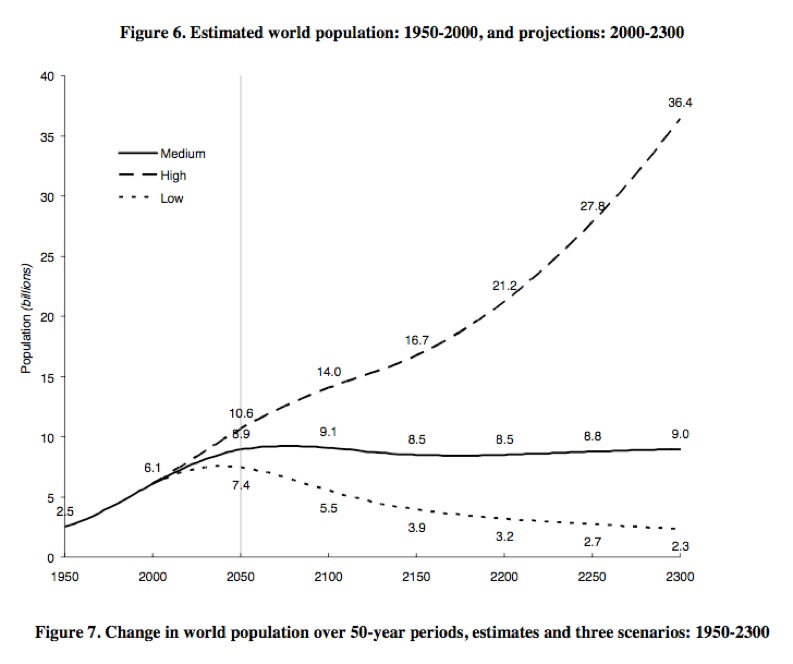This chart shows the long-term effects over the next three centuries of slightly different assumptions about birthrates. The high scenario assumes a birthrate of 2.35 children per woman; the medium assumes 2.1 (replacement level); and the low assumes 1.85 children per woman. From World Population to 2300, United Nations, 2004, p 27
In the book, Australian demographer John Caldwell notes that the “low” scenario relies on a continuation of the current downward trend in birthrates, but it reflects birthrates in European countries higher than they are currently. Here’s what he wrote (pp 1113-114):
The medium
scenario from 2175 posits fertility at replacement
level with long-term stability around 9 billion, a
figure first approximately reached as early as
2045. The low scenario exhibits an eventual total
fertility of 1.85 children per woman and a global
population slowly sinking from 7.5 billion in 2075
to 2.3 billion in 2300 and then continuing to fall at
0.3 per cent per annum. This would mean a fur-
ther halving in the following quarter of a millen-
nium with a 2550 world population back to the
level of 1850. The high scenario is finally charac-
terized by a total fertility of 2.35 children per
woman and a 2300 population of over 36 billion
increasing by 0.54 per cent annually. …
One point should be noted. The relatively mod-
est populations projected for 2050, with low, me-
dium and high scenarios at 7.4 billion, 8.9 billion
and 10.6 billion, respectively, and the modest
peak populations for the low and medium scenar-
ios of 7.5 billion and 9.2 billion are heavily de-
pendent on continuing fertility falls across the de-
veloping world towards sub-replacement fertility
over the next half century. This, in turn, depends
on continuing economic and social globalization,
with all countries eventually becoming consumer
societies. …
Surprisingly, the low scenario is by no means
implausible. It posits a 2100 population of 5.5
billion people, only 27 per cent or two billion per-
sons below the peak, over two generations earlier,
and equal to global population in the early 1990s.
What would render such a population acceptable
is that some sensitive national populations are
projected to be higher in 2300 than is commonly
thought. Some low projections for 2300 of this
type are the following: Germany, 31 million (and
still 40 million in 2200), France, 22 million,
United Kingdom, 26 million and the United
States, 153 million. This would be achieved with a
final total fertility of 1.85 children per woman,
admittedly well above total fertility rates in much
of contemporary Europe…
